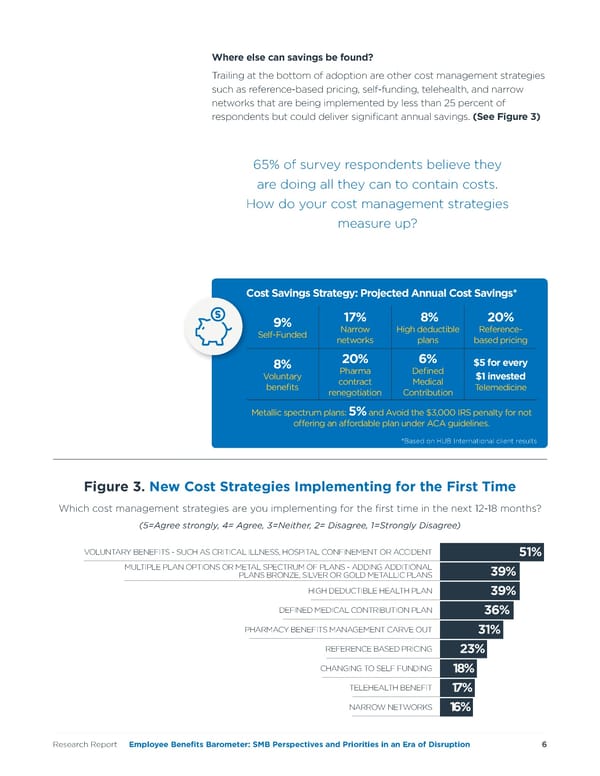Where else can savings be found? Trailing at the bottom of adoption are other cost management strategies such as reference-based pricing, self-funding, telehealth, and narrow networks that are being implemented by less than 25 percent of respondents but could deliver significant annual savings. (See Figure 3) 65% of survey respondents believe they are doing all they can to contain costs. How do your cost management strategies measure up? Cost Savings Strategy: Projected Annual Cost Savings* 9% 17% 8% 20% Self-Funded Narrow High deductible Reference- networks plans based pricing 8% 20% 6% $5 for every Voluntary Pharma Defined $1 invested benefits contract Medical Telemedicine renegotiation Contribution Metallic spectrum plans: 5% and Avoid the $3,000 IRS penalty for not offering an affordable plan under ACA guidelines. *Based on HUB International client results Figure 3. New Cost Strategies Implementing for the First Time Which cost management strategies are you implementing for the first time in the next 12-18 months? (5=Agree strongly, 4= Agree, 3=Neither, 2= Disagree, 1=Strongly Disagree) VOLUNTARY BENEFITS - SUCH AS CRITICAL ILLNESS, HOSPITAL CONFINEMENT OR ACCIDENT 51% MULTIPLE PLAN OPTIONS OR METAL SPECTRUM OF PLANS - ADDING ADDITIONAL 39% PLANS BRONZE, SILVER OR GOLD METALLIC PLANS HIGH DEDUCTIBLE HEALTH PLAN 39% DEFINED MEDICAL CONTRIBUTION PLAN 36% PHARMACY BENEFITS MANAGEMENT CARVE OUT 31% REFERENCE BASED PRICING 23% CHANGING TO SELF FUNDING 18% TELEHEALTH BENEFIT 17% NARROW NETWORKS 16% Research Report | Employee Benefits Barometer: SMB Perspectives and Priorities in an Era of Disruption 6
 Employee Benefits Barometer: SMB Perspectives and Priorities in an Era of Disruption Page 5 Page 7
Employee Benefits Barometer: SMB Perspectives and Priorities in an Era of Disruption Page 5 Page 7